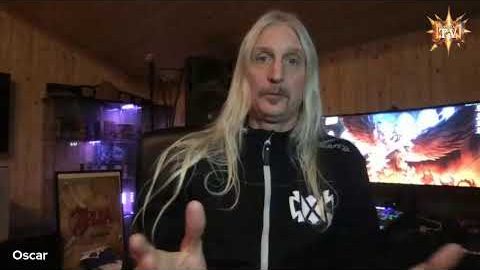
Capable of far more than a slightly sleazy solo (though to be honest that’s part of the appeal) the presence of this golden-hued instrument has elevated hundreds of songs into straight-up super hits. In the business for some woodwind? Look no further…
George Michael, ‘Careless Whisper’ (1984)
Is there a finer pleasure in life than striding down the street as a nearby busker parps their way through the tootling main hook of ‘Careless Whisper’ – putting a distinct strut in your step? Truly, there is not. In glamorous fashion, the melody came to George Michael as he was paying for a bus ticket on the way to a DJ gig, and later down the line he recorded with 11 different saxophonists to get it right. The saxiest of the bunch, Steve Gregory, ended up recording a slower, lower-pitched version which they later sped up. It lends the hook a certain unnatural lightness.
David Bowie, ‘Modern Love’ (1983)
As a kid, David Bowie flicked through some old copies of Melody Maker, and came across the jazz saxophonist Ronnie Ross – who would later play on Lou Reed’s ‘Walk on the Wild Side’. “I was like nine or 10 years old, and I phoned him up and said, “Hello, my name is David Jones, and my dad’s helped me buy a new saxophone, and I need some lessons,” Bowie recounted to Performing Songwriter. He successfully persuaded Ross, and Bowie later ended up playing sax on his own track ‘Changes’. For his 1983 album ‘Let’s Dance’, meanwhile, Bowie recruited a horn section, and opening track ‘Modern Love’ is powered by some of his entire catalogue’s finest saxual healing.
Hall & Oates, ‘Maneater’ (1982)
Originally ‘Maneater’ started life as a reggae track, before Daryl Hall suggested shifting the groove into Motown territory. The woman they’re singing about, Oates told Classic Rock, is actually New York – a bustling city of “greed, avarice, and spoiled riches” – and the sax solo has a kind of neon-lit sleaze, like a wet pavement glowing outside a Meatpacking district dive bar. It’s one of the best known solos from Charles DeChant, Hall & Oates’ leading sax player since 1979.
Carly Rae Jepsen, ‘Run Away With Me’ (2015)
In a tradition that possibly dates back to Bucharest-based Europop pioneer Alexandra Stan and her 2011 horn-playing tribute ‘Mr Saxobeat’, pop has made increasing use of the saxophone over the last decade. And for sheer feel-good factor, it doesn’t get much better than the high drama Celtic-flavoured sax that powers Carly Rae Jepsen’s ‘Run Away With Me’ – a melody so ridiculously memorable that it became a Vine meme in which it was played by everyone from Dolly Parton to Ross Geller.
Gerry Rafferty, ‘Baker Street’ (1978)
Without its wailing saxophone, ‘Baker Street’ might’ve been just another bang average soft-rock number – the original demo features the iconic hook played on guitar. When Raphael Ravenscroft turned up to record a few bits on baritone sax, he suggested playing it on the spare tenor sax in the boot of his car, and the hit was born. Soon the song was in constant rotation on radio, and led to what has been dubbed the ‘Baker Street’ phenomenon – mandatory sax solos everywhere in ‘80s pop. Oddly, ‘Baker Street’ shares another link with the similarly sax-heavy ‘Careless Whisper’ – guitarist Hugh Burns plays on both.
Bruce Springsteen, ‘Born to Run’ (1975)
A colossal slab of wide-eyed rock’n’roll, Bruce Springsteen’s commercial breakthrough ‘Born To Run’ is an operatic epic to chasing “a runaway American Dream” – each vivid scene more saturated than the last. “I want to know if love is real / Oh, can you show me?” Springsteen sings. Clarence Clemons steps into answer with an enormous sax solo giddy on joy and excitement. Something of a legend in the medium, Clemons also lent his woodwind talents to…
Lady Gaga, ‘The Edge of Glory’ (2011)
On ‘Born This Way’, Lady Gaga brought together Eurotrash excess and shoddy attempts at speaking German (see: ‘Scheiße’) with straight-up rock ambition direct from the playbook of one of her favourite artists, Bruce Springsteen. In fact, when it came to injecting some sax factor into ‘The Edge of Glory’, Gaga rang up E Street Band member Clarence Clemons and asked him to fly to New York to record that very same day. He injects an effortless sense of fun that felt missing from other mainstream pop music at that time – and Lady Gaga dug back into ‘80s pop revival long before it was everywhere again.
Sade, ‘Smooth Operator’ (1984)
Outrageously slinky, ‘Smooth Operator’’s parping sax is as suave as the professional heartbreaker at the heart of the song. Melting hearts from “coast to coast”, this fairly unsavoury character may have eyes like angels “but his heart is cold”, warns Sade Adu. Deliciously sleazy alto winds its way through the entire song in a pair of velvet loafers (probably with no socks, and slightly clammy feet). It’s the perfect match for its playboy protagonist.
Whitney Houston, ‘I Will Always Love You’ (1992)
A cover of Dolly Parton’s country-tinged original, Whitney Houston’s version of ‘I Will Always Love You’ – recorded for 1992 schmoozy movie The Bodyguard – amps up the ballad factor and makes belting use of Houston’s powerhouse vocal. And just when you think things can’t possibly get any more dramatic, in comes a yearning-filled sax solo from Kirk Whalum – who over the years has also lent his talents to Luther Vandross, Everything But The Girl, and Al Green.
Kendrick Lamar, ‘Alright’ (2015)
Drawing on a series of genres including funk, jazz, and soul, Kendrick Lamar’s third album ‘To Pimp A Butterfly’ draws heavily from Black music tradition and explores a broken America fuelled by racism and inequality. Later adopted as an anthem of the Black Lives Matter movement, ‘Alright’ is a moment of hope: “Do you hear me, do you feel me? We gonna be alright,” Lamar proclaims. It’s underpinned by far-ranging, jazz-influenced sax from collaborator Terrance Martin, giving the track a classic cinematic quality.
Lou Reed, ‘Walk on the Wild Side’ (1972)
Produced by David Bowie and Spiders With Mars member Mick Ronson, Lou Reed’s twangy anthem for Andy Warhol’s Factory superstars fades out with a honeyed sax solo, which could happily keep going into infinity. To create the famous rock’n’roll moment, Bowie booked his childhood saxophone teacher Ronnie Ross and turned up to surprise him at the session.
Pink Floyd, ‘Us and Them’ (1973)
Melancholy and beautiful, ‘Dark Side of the Moon’’s jazz-influenced epic sees the band reflect on the needless nature of war, which rips apart the lives of ordinary people while those in positions of power sit back and painstakingly move border lines around on a map. Offering pockets of reflection between the increasingly epic choruses, Richard Parry’s tootling solos cut through the wall of sound. Fun fact: his horns are also featured on Floyd’s ‘Money’.
Billy Joel, ‘Scenes from an Italian Restaurant’ (1977)
By the time Billy Joel started working on ‘The Strangers’, he was under pressure to deliver a commercial hit. Bolstered by a new go-to live back, he wanted to write an album that showcased his musicianship. A concept record of a kind, it hinges around various characters from around New York City and their fruitless pursuits of the American dream. “A bottle of white, a bottle of red / Perhaps a bottle of rosé instead?” begins ‘Scenes From an Italian Restaurant’, borrowing a line Joel heard a waiter say in the since-closed Fontana di Trevi, an Italian restaurant opposite the Carnegie Hall. Framed by two similar sax solos by Richie Cannata, ‘Scenes From an Italian Restaurant’ is one of Joel’s greatest everyday epics, inspired by the stories that unfolded inside said establishment.
Stevie Wonder, ‘Sir Duke’ (1996)
One of the horniest songs on earth – in the most literal sense of the word – Stevie Wonder’s ‘Sir Duke’ is a brass bonanza, celebrating the influence of the late jazz composer and musician Duke Ellington. Given even further welly by two trumpets, the song features a pair of saxophonists who deliver some of the best known sax lines in music. Hank Redd, on alto, is incidentally credited as a writer on Rihanna’s 2005 debut ‘Music of the Sun’ – his baritone counterpart Trevor Lawrence has also played on tracks by Marvin Gaye and Carly Simon, as well as co-producing Pointer Sisters’ ‘So Excited!’
Men At Work, ‘Who Can It Be Now?’ (1981)
There’s a fidgety, wonky undercurrent to ’80s Aussie rockers’ Men At Work’s ‘Who Can It Be Now’ – and much of this comes down to the band’s Greg Ham and his tenacious sax hook, which weaves its way through the entire new wave number. The parping solo itself was recorded in a single take. The inescapable main melody later cropped up on Jason Derulo’s mildly irritating cowbell fest ‘Love Hangover’. So, OK, sax solos aren’t all good news.
The post Parp stars: the 15 best saxophone solos in pop appeared first on NME.


